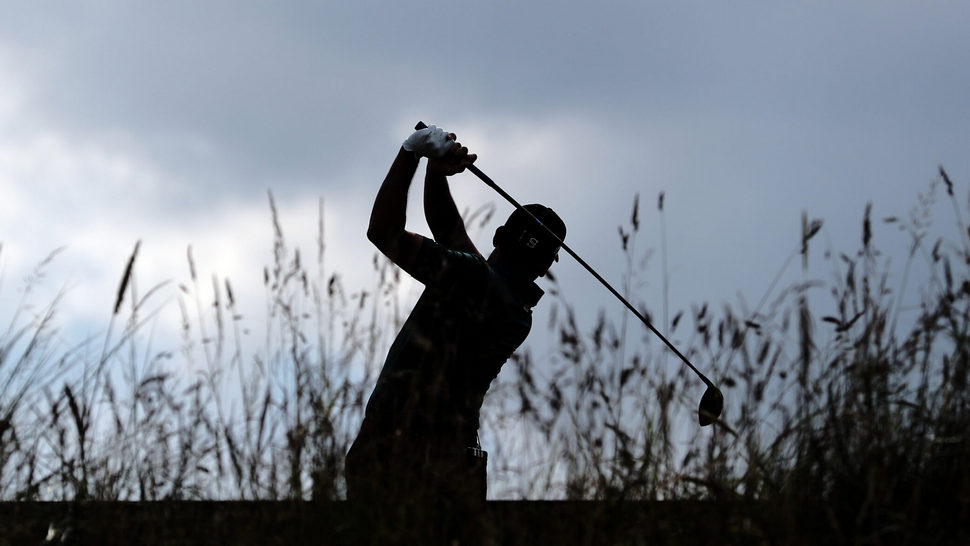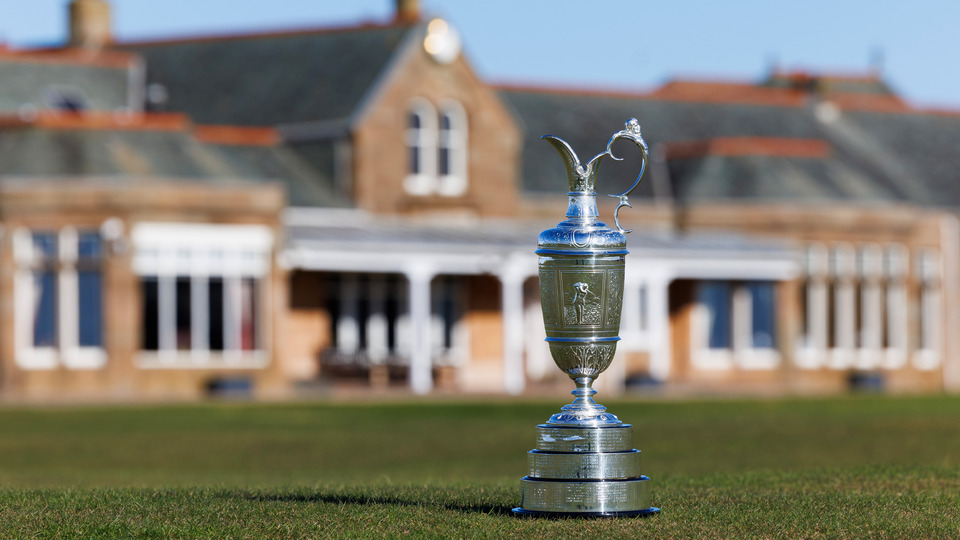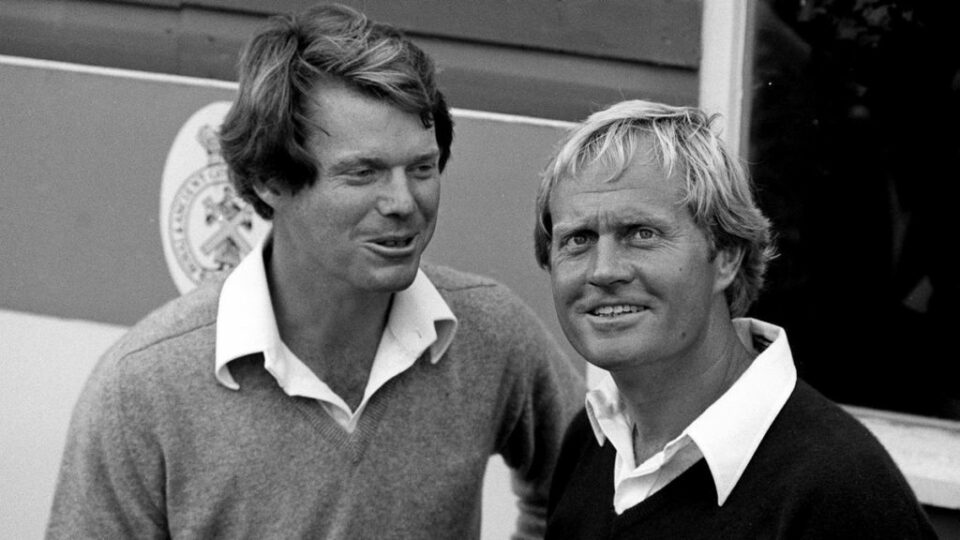Tuition
Bunker Basics
Finding your ball in a greenside trap fill you with dread? Help is at hand. In the first part of our new instruction series written by ladies for ladies, Lynn McCool, Director of Golf and Head Professional at the wonderful Lough Erne Resort in Northern Ireland, explains why learning to generate more clubhead speed through the sand is the secret to escaping successfully first time, every time.It doesn’t matter whether you are eight or eighty years old, the one thing that the average lady club golfer has in common with all her counterparts is the belief that you can use the same technique as you would to chip the ball from greenside grass to play a regular bunker shot. Wrong. The simple reality is that if you want to glide the clubhead through the sand beneath the ball – your No.1 objective here – you have to commit to accelerating the clubhead through impact at significant speed.Speed is of the essence: a commitment to accelerating the clubhead all the way through the sand – extending the arms free – produces the desired result.While there are the obvious benefits of clubhead speed for generating power and distance off the tee, few ladies appreciate that it is also required to play bunker shots successfully. Without acceleration to a completed follow-through it is virtually impossible to splash the ball out of the bunker and onto the green with any sort of consistency.
In fact lady golfers aren’t alone in fearing the dreaded sand shot; there are plenty of men who avoid going into bunkers at all costs, too. Even though men have greater natural strength and therefore the ability to generate clubhead speed, many don’t realise that they need to use this in a bunker and attempt to play sand shots with a delicate action that inevitably fails to get the ball out. So, the key to successful sand shots is acceleration with good arm extension – never quit.
"Speed is of the essence: a commitment to accelerating the clubhead all the way through the sand – extending the arms free – produces the desired result."
As with every shot in golf it is important to remind yourself of the basics, so I’m going to give you a refresher course in the fundamentals that will make the greenside sand shot easy. After that a selection of simple drills that you can practice to improve your clubhead speed. As you’re about to discover, once you learn to accelerate the clubhead through the sand you’ll never panic when faced with a bunker shot again.
Bunker Basics The Set Up
There are four fundamentals that you must get right in order to address the ball correctly in the bunker…
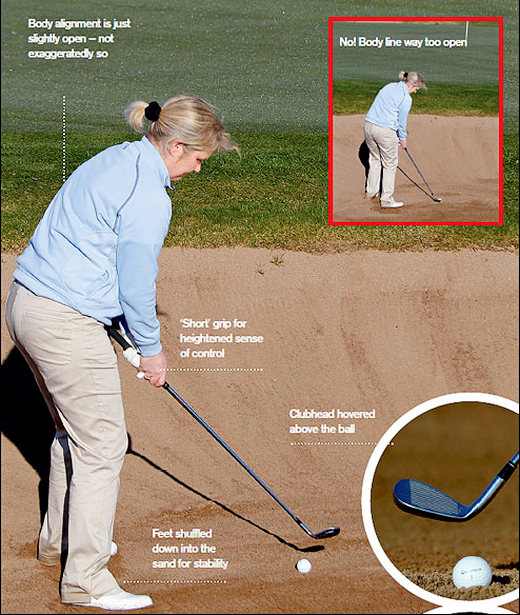
2. Shuffle your feet down into sand. This will enable you to feel the texture of the sand and get some idea as to its consistency – i.e. deep or shallow, fine or heavy. It also gives your stance a solid base and prevents the feet from shifting as you make your swing, which is easily done on a soft, unstable surface. This stable base will also help lower your centre of gravity closer to the sand, giving you a much greater chance of splashing the ball out on a bed of sand.
3. Position the ball between the centre of your stance and left heel. This is a detail you should experiment with until you find the position that matches up with the bottom of your swing arc, thus enabling you to slide the clubface underneath the ball. [With the ball too far back you will be prone to hitting bunker shots ‘heavy’ as the club will still be on its descent; conversely, play the ball too far forward you are likely to thin a lot of these shots as the club is travelling ‘on the up’.
4. Hover the club above the ball. A common mistake many golfers make is to hover the club directly behind the ball just above the sand. This encourages a shallow takeaway and makes it difficult to get the club travelling on the correct steep path in the backswing. By hovering the club three inches directly above the ball you will naturally pick the club up steeper.
Body Alignment & Aim
The ideal set up for a sand shot is to aim the body just a touch left of the flag, perhaps between 10 and 20 degrees, the leading edge of the club pointing at the target. What you don’t want to do is exaggerate this adjustment, so that you end up with your body aiming way to the left of the target (framed red above – a common fault that makes it very difficult to synchronise the movement of your arms and body).

THINK 'SOFT HANDS' When it comes to grip pressure, imagine you have a delicate bird in your hands. In other words, change your grip pressure from the usual 7 or 8 on a scale of 1=light, 10=tight, to around 3 or 4. With a lighter grip pressure you'll be able to generate more clubhead speed
In reality modern sand wedges have such a good design that if you want to keep things really simple you can address the bunker shot with your stance and clubface virtually square to the target and there will still be plenty of ‘bounce’ in effect to ensure the clubhead glides through the sand and the ball pops out.
Most important of all, once you are set up and ready to go, remember to engage your wrists early so that you pick the club up a little steeper in the backswing than usual – this will ensure that you create the angle necessary to slap the flange of the sand iron into the sand, literally removing a divot of sand from beneath the ball.
Distance Control
If you master the basics and work on your speed drills you will soon discover a renewed confidence in your sand play. The next step is to add finesse and learn to control the landing distance on the green. So let me leave you with a couple of ideas to experiment with, two key factors influence distance control: (1) the length of your swing and (2) the amount of sand you take from beneath the ball. Make a mental note, however, that your swing tempo must remain constant. Even for a shorter bunker shot you must still be aggressive and accelerate through the sand.
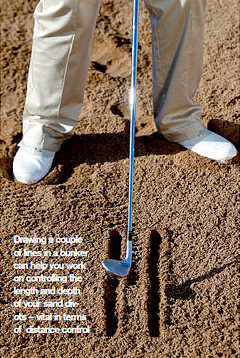
Drawing a couple of lines in a bunker can help you work on controlling the length and depth of your sand divots - vital in terms of distance control

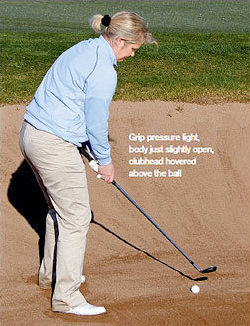
Grip pressure light, body just slightly open, clubhead hovered above the ball

Make your swing along the line of your toes, allowing the wrists to hinge up nicely
A more advanced technique involves regulating the amount of sand that you take. This requires a good deal of practice, and there’s a very effective way of going about it: draw two lines in the sand perpendicular to the direction of your target, as you see above. The first line represents your point of entry; the second indicates where the ball would be positioned. Set up with the club hovered above that first line and work on your technique until you can produce a set of consistent sand divots. The more sand you take before the ball the shorter your shots and the less sand you take before sliding beneath the ball the further your shots will travel. Over time you will develop a significant sense of feel for the depth of sand taken.
Try these Speed Drills
As I’ve said already, the absolute key to playing bunker shots successfully is to be aggressive with your attack. Don’t be afraid of hitting the sand but be positive and swing the club with total commitment.You don’t need to worry about the ball travelling too far; the sand acts as a cushion, absorbing the power. The following drills will train you to become aggressive with your approach to bunker shots, accelerating through the sand rather than quitting.1. Tee to target
Replace your golf ball with a tee peg turned upside down and positioned in the middle of your stance. Taking your regular set-up, practice splashing the tee peg out of the bunker. This tiny target really grabs your attention and helps you to focus on hitting a specific point in the sand. Believe it or not, you’ll actually have to be more aggressive to splash a tee peg onto the green than a golf ball, as although it is lighter, it won’t travel as far!
“Work on the speed drills to build confidence in striking the sand – when you then play the shot for real the ball will float out on a cushion of sand every time”
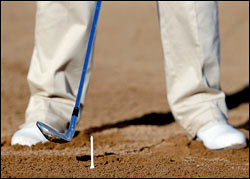
Another very simple drill involves no object at all – simply practice splashing the sand out of the bunker and onto the green. Use your new committed swing and really get the clubhead gliding through the sand. Extend your arms towards the target in the throughswing and watch the sand fly up into the air.3. Splash a coin
Place a coin in the centre of your stance where the ball would be positioned and practice splashing it out onto the green. Because the coin is flat the club will be forced to slide beneath the coin, collecting it on a bed of sand and floating it out onto the green. When you have mastered this action replace the coin with a golf ball and you’ll instantly notice the difference.

